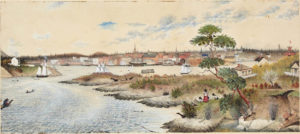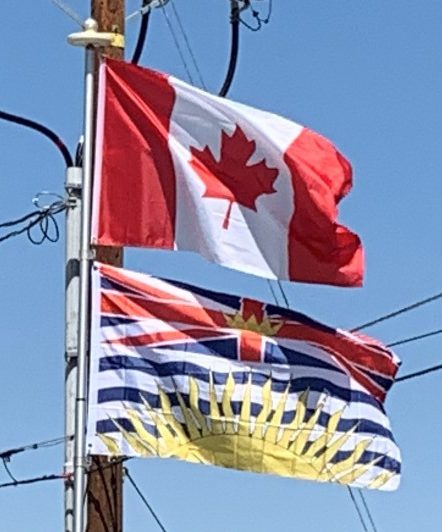The establishment of trading posts under the auspices of the North West Company and the Hudson’s Bay Company (HBC), effectively established a permanent British presence in the region. The Columbia District was broadly defined as being south of 54°40 north latitude, (the southern limit of Russian America), north of Mexican-controlled California, and west of the Rocky Mountains. It was, by the Anglo-American Convention of 1818, under the “joint occupancy and use” of citizens of the United States and subjects of Britain (which is to say, the fur companies). This co-occupancy was ended with the Oregon Treaty of 1846.
Until 1849, these districts were a wholly unorganized area of British North America under the de facto jurisdiction of HBC administrators. Unlike Rupert’s Land to the north and east, however, the territory was not a concession to the company. Rather, it was simply granted a monopoly to trade with the First Nations inhabitants. All that was changed with the westward extension of American exploration and the concomitant overlapping claims of territorial sovereignty, especially in the southern Columbia Basin (within present day Washington and Oregon). In 1846, the Oregon Treaty divided the territory along the 49th parallel to the Strait of Georgia, with the area south of this boundary (excluding Vancouver Island and the Gulf Islands) transferred to sole American sovereignty. The Colony of Vancouver Island was created in 1849, with Victoria designated as the capital. New Caledonia, as the whole of the mainland rather than just its north-central Interior came to be called, continued to be an unorganized territory of British North America, “administered” by individual HBC trading post managers.
Colony of British Columbia (1858–66):
With the Fraser Canyon Gold Rush in 1858, an influx of Americans into New Caledonia prompted the colonial office to designate the mainland as the Colony of British Columbia. When news of the Fraser Canyon Gold Rush reached London, Richard Clement Moody was hand-picked by the Colonial Office, under Sir Edward Bulwer-Lytton, to establish British order and to transform the newly established Colony of British Columbia into the British Empire’s “bulwark in the farthest west” and “found a second England on the shores of the Pacific”.
By 1862, the Cariboo Gold Rush, attracting an additional 5000 miners, was underway, and Douglas hastened construction of the Great North Road (commonly known now as the Cariboo Wagon Road) up the Fraser Canyon to the prospecting region around Barkerville. By the time of this gold rush, the character of the colony was changing, as a more stable population of British colonists settled in the region, establishing businesses, opening sawmills, and engaging in fishing and agriculture.

Later Gold Rushes:
A series of gold rushes in various parts of the province followed, the largest being the Cariboo Gold Rush in 1862, forcing the colonial administration into deeper debt as it struggled to meet the extensive infrastructure needs of far-flung boom communities like Barkerville and Lillooet, which sprang up overnight. The Vancouver Island colony was facing financial crises of its own, and pressure to merge the two eventually succeeded in 1866, when the colony of British Columbia was amalgamated with the Colony of Vancouver Island to form the Colony of British Columbia (1866–71), which was, in turn, succeeded by the present day province of British Columbia following the Canadian Confederation of 1871.
Rapid Growth and Development:
The Confederation League, including such figures as Amor De Cosmos, John Robson, and Robert Beaven, led the chorus pressing for the colony to join Canada, which had been created out of three British North American colonies in 1867 (the Province of Canada, Nova Scotia and New Brunswick). Several factors motivated this agitation, including the fear of annexation to the United States, the overwhelming debt created by rapid population growth, the need for government-funded services to support this population, and the economic depression caused by the end of the gold rush.
